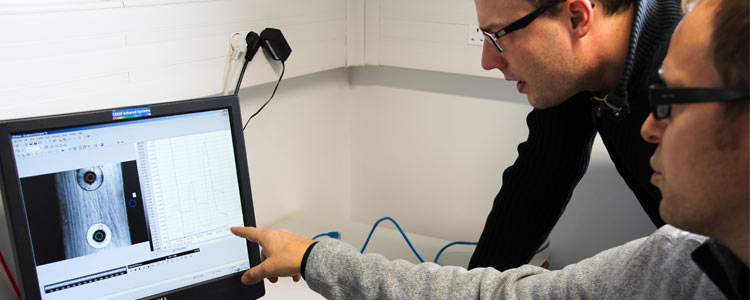Period, duration
February-July 2022, 4 months
Profile required
M2 Instrumentation student
Bonus
3,90€ /h
Location
Annecy-le-vieux ; Maison de la mécatronique ; Symme laboratory
Subject
This internship is part of the development of a device for locating people in a habitat, without the need for wearable sensors or devices such as telephones. Step-sensitive sensors placed in the habitat could locate the footsteps of the inhabitants using the trilateration technique, in order to obtain a "Marauder's Map" type map in Harry Potter. To achieve this, a new type of sensor is used, based on an original, non-Newtonian component: silly putty, combined with graphene.
Initial conclusive tests carried out in collaboration between SYMME and LISTIC have led to the development of a sensor demonstrator, whose operating principle is based on the measurement of sudden changes in the conductive properties of a composite material when mechanical stress is applied. Without amplification, the device thus developed has a sensitivity of the same order of magnitude as the most powerful seismic sensor on the market, which incorporates amplification by a factor of 50. However, the developed sensor delivers a non-linear response, albeit reproducible for a repeatable load, but with a temporal drift. This behavior makes it difficult to identify the transducer's transfer function using conventional methods. The working hypothesis for continuing the study is that the transducer response can be characterized by a non-linear model, with some parameters undergoing temporal drift. In order to validate this hypothesis, a large number of automated experiments need to be carried out, in particular at low-energy levels of sensor solicitation comparable to the micro-seismic energy produced by human footsteps a few metres apart. The scientific challenge therefore lies in stimulating and measuring ultra-low-energy seismic signals.
The student recruited will have to set up a test bench to automate seismic sensor measurements:
- assembly of the piezoelectric actuator for reproducible vibration generation,
- design of an acquisition system to collect signals from the reference sensors and the sensors to be characterized,
- measurement automation,
- processing of the data generated.
It will be possible to obtain a large amount of data, which will be processed at the end of the project by LSITIC to determine the transfer function. The student will have at his disposal the equipment of the SYMME laboratory (mechatronics room, sensors, 3D printer, electronic components) and of LISTIC (solutions for storing measurements and indexing in a dedicated database) to carry out his work.
Keywords: seismic sensor, automation, characterization
------------------------------------
This internship is part of the development of a device allowing the localization of people in a habitat, without wearable sensors or devices such as phones. Sensors sensitive to the steps placed in the habitat could locate the steps of the inhabitants by the technique of trilateration, in order to obtain a map like the "Marauder's map" in Harry Potter. For this, a new type of sensor is used, based on a non-Newtonian and original component: the silly putty, associated with graphene.
Initial tests conducted in collaboration between SYMME and LISTIC have led to the development of a sensor demonstrator, whose operating principle is based on the measurement of sudden changes in the conductive properties of a composite material when a mechanical stress is applied. Without amplification, the device thus developed has a sensitivity of the same order of magnitude as the most powerful seismic sensor on the market, which incorporates a factor of 50 in amplification. However, the developed sensor delivers a non-linear response although reproducible for a repeatable solicitation, but with a temporal drift. This behavior makes it difficult to identify the transfer function of the sensor by traditional methods. The working hypothesis to continue the study is that the sensor response can be characterized by a non-linear model, with some parameters undergoing a temporal drift. In order to validate this hypothesis, a large number of automated experiments must be carried out, in particular at low-energy levels of solicitation of the sensor comparable to the micro-seismic energy produced by human steps a few meters apart. The scientific challenge lies in the stimulation and measurement of ultra-low energy seismic signals.
The student will have to set up a test bench allowing the automation of the seismic sensor measurements:
- assembly of the piezoelectric actuator for the reproducible generation of vibrations,
- design of an acquisition system to collect the signals from the reference sensors and the sensors to be characterized,
- automation of the measurements,
- processing of the generated data.
It will thus be possible to obtain a large amount of data, which will be processed at the end of the project by the LSITIC in order to determine the transfer function. The student will have at his disposal the equipment of the SYMME laboratory (mechatronics room, sensors, 3D printer, electronic components) and of the LISTIC (solutions for storing measurements and indexing in a dedicated database) to carry out his work.
Contact
Thomas.Mazingue
@univ-smb.fr
Project team
Thomas Mazingue, teacher-researcher Polytech Annecy-Chambéry/ SYMME
Luc Maréchal, teacher-researcher Polytech Annecy-Chambéry/ SYMME
Éric Benoit, teacher-researcher IUT Annecy GEII / LISTIC
